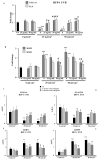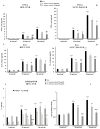Phytocomplex of a Standardized Extract from Red Orange (Citrus sinensis L. Osbeck) against Photoaging
- PMID: 35563752
- PMCID: PMC9103794
- DOI: 10.3390/cells11091447
Phytocomplex of a Standardized Extract from Red Orange (Citrus sinensis L. Osbeck) against Photoaging
Abstract
Excessive exposure to solar radiation is associated with several deleterious effects on human skin. These effects vary from the occasional simple sunburn to conditions resulting from chronic exposure such as skin aging and cancers. Secondary metabolites from the plant kingdom, including phenolic compounds, show relevant photoprotective activities. In this study, we evaluated the potential photoprotective activity of a phytocomplex derived from three varieties of red orange (Citrus sinensis (L.) Osbeck). We used an in vitro model of skin photoaging on two human cell lines, evaluating the protective effects of the phytocomplex in the pathways involved in the response to damage induced by UVA-B. The antioxidant capacity of the extract was determined at the same time as evaluating its influence on the cellular redox state (ROS levels and total thiol groups). In addition, the potential protective action against DNA damage induced by UVA-B and the effects on mRNA and protein expression of collagen, elastin, MMP1, and MMP9 were investigated, including some inflammatory markers (TNF-α, IL-6, and total and phospho NFkB) by ELISA. The obtained results highlight the capacity of the extract to protect cells both from oxidative stress—preserving RSH (p < 0.05) content and reducing ROS (p < 0.01) levels—and from UVA-B-induced DNA damage. Furthermore, the phytocomplex is able to counteract harmful effects through the significant downregulation of proinflammatory markers (p < 0.05) and MMPs (p < 0.05) and by promoting the remodeling of the extracellular matrix through collagen and elastin expression. This allows the conclusion that red orange extract, with its strong antioxidant and photoprotective properties, represents a safe and effective option to prevent photoaging caused by UVA-B exposure.
Keywords: IL-6; MMPs; ROS; TNF-α; antioxidant activity; collagen; comet assay; cyanidin; elastin; flavonoids.
Conflict of interest statement
The authors declare no conflict of interest.
Figures













Similar articles
-
Photoprotective and Antiaging Effects of a Standardized Red Orange (Citrus sinensis (L.) Osbeck) Extract in Asian and Caucasian Subjects: A Randomized, Double-Blind, Controlled Study.Nutrients. 2022 May 27;14(11):2241. doi: 10.3390/nu14112241. Nutrients. 2022. PMID: 35684041 Free PMC article. Clinical Trial.
-
Protective effect of red orange extract supplementation against UV-induced skin damages: photoaging and solar lentigines.J Cosmet Dermatol. 2014 Jun;13(2):151-7. doi: 10.1111/jocd.12083. J Cosmet Dermatol. 2014. PMID: 24910279
-
Downregulation of MMP1 expression mediates the anti-aging activity of Citrus sinensis peel extract nanoformulation in UV induced photoaging in mice.Biomed Pharmacother. 2021 Jun;138:111537. doi: 10.1016/j.biopha.2021.111537. Epub 2021 Apr 5. Biomed Pharmacother. 2021. PMID: 34311535
-
Anti-photoaging and photoprotective compounds derived from marine organisms.Mar Drugs. 2010 Apr 8;8(4):1189-202. doi: 10.3390/md8041189. Mar Drugs. 2010. PMID: 20479974 Free PMC article. Review.
-
Ultraviolet A protective potential of plant extracts and phytochemicals.Biomed Pap Med Fac Univ Palacky Olomouc Czech Repub. 2020 Mar;164(1):1-22. doi: 10.5507/bp.2020.010. Epub 2020 Mar 17. Biomed Pap Med Fac Univ Palacky Olomouc Czech Repub. 2020. PMID: 32188958 Review.
Cited by
-
Dysregulation of autophagy during photoaging reduce oxidative stress and inflammatory damage caused by UV.Front Pharmacol. 2025 May 12;16:1562845. doi: 10.3389/fphar.2025.1562845. eCollection 2025. Front Pharmacol. 2025. PMID: 40421222 Free PMC article. Review.
-
Effects of oral intake fruit or fruit extract on skin aging in healthy adults: a systematic review and Meta-analysis of randomized controlled trials.Front Nutr. 2023 Aug 4;10:1232229. doi: 10.3389/fnut.2023.1232229. eCollection 2023. Front Nutr. 2023. PMID: 37599694 Free PMC article.
-
Standardized Extract from Wastes of Edible Flowers and Snail Mucus Ameliorate Ultraviolet B-Induced Damage in Keratinocytes.Int J Mol Sci. 2023 Jun 15;24(12):10185. doi: 10.3390/ijms241210185. Int J Mol Sci. 2023. PMID: 37373341 Free PMC article.
-
Photoprotective and Antiaging Effects of a Standardized Red Orange (Citrus sinensis (L.) Osbeck) Extract in Asian and Caucasian Subjects: A Randomized, Double-Blind, Controlled Study.Nutrients. 2022 May 27;14(11):2241. doi: 10.3390/nu14112241. Nutrients. 2022. PMID: 35684041 Free PMC article. Clinical Trial.
-
Extremophilic Solutions: The Role of Deinoxanthin in Counteracting UV-Induced Skin Harm.Curr Issues Mol Biol. 2023 Oct 16;45(10):8372-8394. doi: 10.3390/cimb45100528. Curr Issues Mol Biol. 2023. PMID: 37886971 Free PMC article.
References
-
- De Jager T.L., Cockrell A.E., Du Plessis S.S. Ultraviolet light induced generation of reactive oxygen species. Adv. Exp. Med. Biol. 2017;996:15–23. - PubMed
Publication types
MeSH terms
Substances
LinkOut - more resources
Full Text Sources
Medical
Miscellaneous

